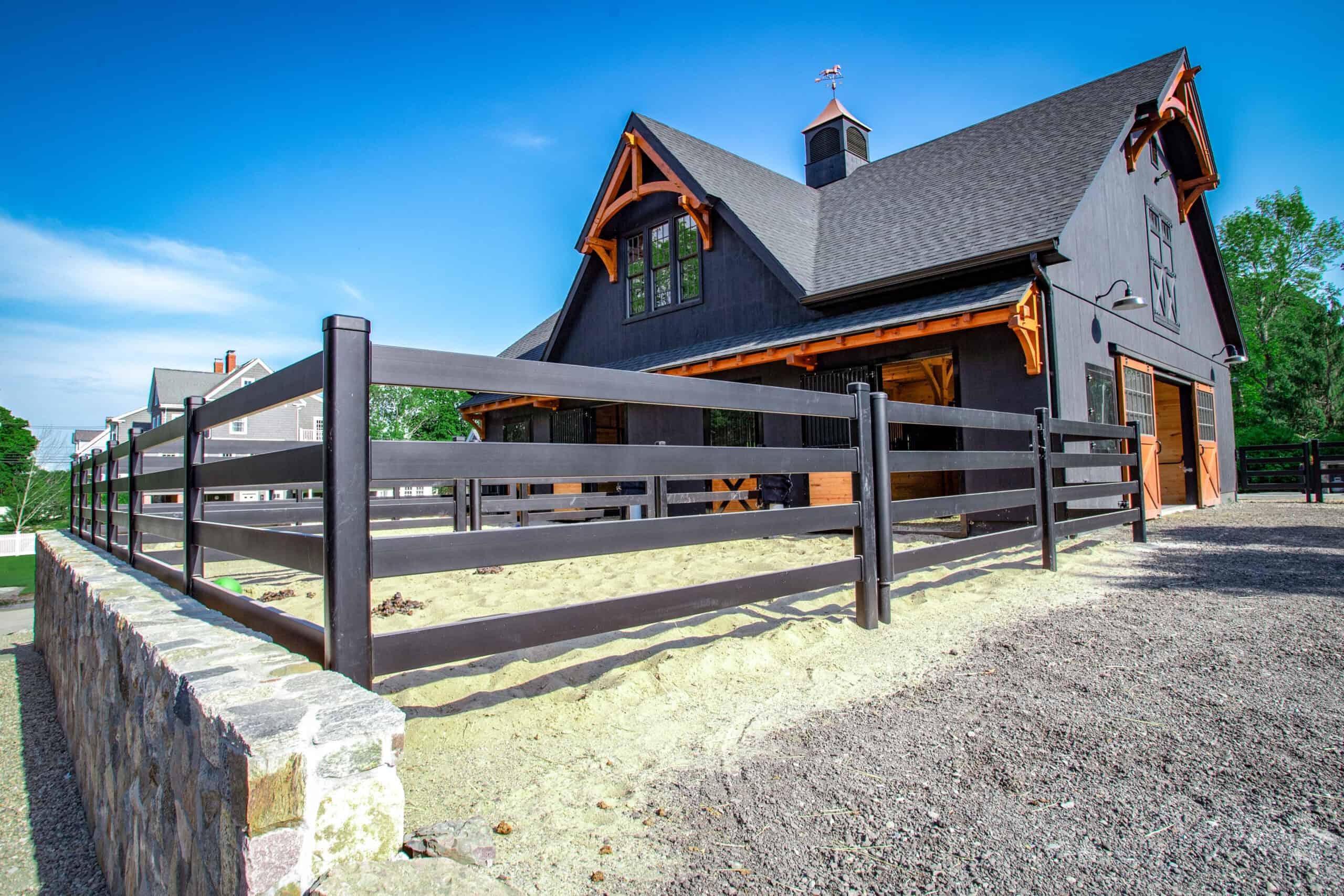You got horses to enjoy your weekends, not spend them fixing fences.
Yet here you are, painting boards again. Or re-tensioning wire that’s gone slack. Or replacing another section that couldn’t handle last week’s storm. The cycle never ends with traditional horse fencing. There’s always something that needs attention when you’d rather be riding.
“Maintenance-free” gets thrown around a lot in marketing for different types of fencing, but most of it’s wishful thinking. True low-maintenance fencing exists, but you need to separate the real solutions from the sales pitches. Some materials genuinely deliver decades of reliable service with minimal intervention. Others just delay the inevitable repairs while looking good in brochures.
The difference matters more than you might think. Over twenty years, a truly maintenance-free fence can cost less than cheap options that need constant attention. More importantly, it buys you back those weekends spent with tools instead of horses.
Below, we’ll look at what actually works for busy horse owners who want reliable boundaries without the ongoing headaches.
What Is a Maintenance-Free Fence?
Maintenance-free doesn’t mean you’ll never look at your fence again. It means the fence handles weather, horses, and time without requiring regular intervention to function properly.
- Weather resistance without protective treatments tops the list. Truly low-maintenance fencing stands up to sun, rain, snow, and temperature swings without needing paint, stain, or protective coatings to prevent deterioration. The materials themselves resist rust, rot, and UV damage for decades.
- Impact durability that bounces back from horse contact separates maintenance-free options from everything else. Horses lean, rub, and occasionally run into fencing. Low-maintenance systems absorb these impacts and return to their original position without permanent damage or structural compromise.
- Color retention without painting means the fence looks professional year after year without touch-ups. Quality materials maintain their appearance through weather exposure, preventing the faded, weathered look.
- Structural integrity over decades distinguishes truly maintenance-free fencing from options that simply delay problems. The posts stay straight, connections remain solid, and the overall system maintains its strength and alignment without ongoing adjustments or replacements.
Still, even maintenance-free fencing benefits from occasional inspection and basic care, but it doesn’t demand weekend projects to remain functional and attractive.
3 Best Maintenance-Free Fencing for Horses
1. Steel Board Fencing
Steel board fencing delivers genuine maintenance-free performance that lasts decades. The galvanized steel construction resists rust and corrosion far longer than any coating or treatment, while the architectural-grade powder coating maintains its appearance without painting or touch-ups.
The flexible rail design sets steel board apart from rigid alternatives. When horses impact the fence (and they will), the rails absorb the energy and flex back to position without breaking, cracking, or creating dangerous sharp edges. This engineering prevents both fence damage and horse injuries.
Posts anchored in concrete provide permanent stability that eliminates the sagging, leaning, and shifting common with other systems. No re-tensioning wire, no replacing rotted posts, no straightening panels that have shifted over time.
The 30+ year performance track record speaks for itself. Steel board fencing installed in the 1990s continues performing without major maintenance, making it the smart investment for horse owners who want to build once and focus on their animals rather than their fencing.
2. Vinyl/PVC Fencing
Vinyl fencing appeals to horse owners seeking the appearance of painted wood without the painting. Quality vinyl systems eliminate the need for staining, sealing, or protective treatments while providing smooth surfaces that won’t splinter or create rough edges.
It has an easy cleaning advantage: soap and water remove most dirt and stains, maintaining a professional appearance with minimal effort. Various styles and colors offer flexibility for matching property aesthetics or personal preferences.
However, vinyl’s maintenance-free reputation comes with a few caveats. UV exposure gradually breaks down the material, causing brittleness that leads to cracking and impact damage after 10-15 years. Temperature extremes create expansion and contraction that can work connections loose or cause panels to bow.
When damage occurs, repair options are limited. Unlike steel or wood systems where individual components can be fixed, vinyl often requires complete panel replacement. The material also shows scuff marks and discoloration over time, particularly in high-traffic areas where horses congregate.
For moderate climates and careful horse management, quality vinyl can provide 15-20 years of relatively low-maintenance service before major issues develop.
3. Aluminum Fencing
Aluminum fencing offers corrosion resistance and professional appearance with minimal ongoing maintenance requirements. The material naturally oxidizes on the surface, creating a protective layer that prevents deeper deterioration without protective coatings.
Modern aluminum systems feature powder-coated finishes that maintain their appearance for years without painting or touch-ups. The lightweight nature simplifies installation while the smooth surfaces eliminate splinter risks and provide easy cleaning.
However, aluminum’s strength limitations make it questionable for serious horse containment. The material simply lacks the structural integrity to handle determined horses or impact from large animals. What works for decorative applications or small paddocks may fail catastrophically when tested by energetic horses.
Cost considerations also factor heavily: quality aluminum fencing often approaches steel board pricing while delivering significantly less durability and containment capability. The material works well for specific applications like property boundaries or areas where horses have limited access, but it’s not the primary containment solution most horse operations need.
High-Maintenance Fencing to Avoid
Some fencing options look affordable upfront but turn into weekend-stealing maintenance nightmares that cost more in time and money than premium solutions. Here’s what to avoid if you actually want to enjoy your horses instead of constantly fixing their containment.
- Wood rail fencing: The classic look comes with endless maintenance demands including annual painting or staining, regular board replacement from warping and splitting, post replacement every 7-10 years due to ground-level rot, and constant nail/screw checks as wood expands and contracts seasonally.
- Wire fence systems
- High tensile wire: Require seasonal re-tensioning as temperature changes affect wire tension, regular electrical maintenance for energized systems, ongoing visibility enhancement since horses can’t see plain wire clearly, and frequent connection point repairs where wires attach to posts or insulators.
- Chain link mesh: Needs regular re-tensioning to prevent sagging, rust treatment and eventual replacement of galvanized coating, gate hardware lubrication and adjustment, and ongoing repairs where horses damage mesh through rubbing or impact.
- Welded wire panels: Require frequent connection point tightening as panels work loose, rust prevention maintenance on cheaper galvanized options, and panel replacement when horses bend or break the relatively lightweight construction.
- Electric tape and rope: Demand constant electrical monitoring to guarantee proper voltage levels, regular replacement of tape/rope as UV exposure causes deterioration, ongoing vegetation management to prevent grounding issues, and frequent repairs from horse damage or weather exposure.
Invest in Freedom from Fence Work
The math is simple: you can spend weekends fixing cheap fencing or invest once in fencing that frees up those weekends for riding. Over twenty years, truly maintenance-free fencing costs less than constantly repairing budget options—and that’s before you factor in the value of your time.
Steel board fencing delivers what others promise: decades of reliable performance without the painting, repairs, or replacements that turn fence ownership into a second job. Your horses deserve secure boundaries, and you deserve to enjoy them without constant maintenance headaches.
Ready to build once and focus on horses instead of fencing? Contact us today for a free quote, and let’s design your perfect fence.



